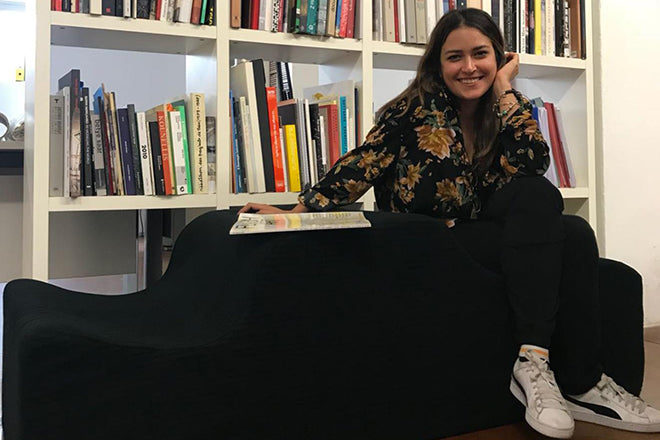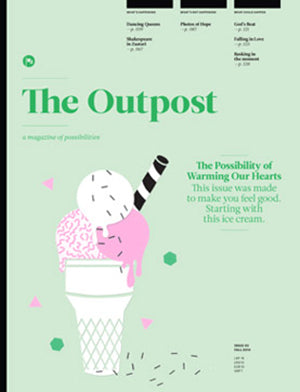
Bana Bissat, Flash Art
This week we are in Milan with Bana Bissat, who covers marketing and advertising for Flash Art. Its recent redesign has brought in a new readership while respecting their loyal following built up over 50 years. Bana explains this and more before the magazine’s summer shutdown.
Tell us about your typical Monday journey to work
My 50-minute commute from the south of Milan to the north is an important part of my day and is very enjoyable. Milan is most exciting in the mornings and I follow a strict routine of people-watching on my walk to the metro, then on my metro to the tram, and lastly, on the tram where public transportation theatre never fails to disappoint.
Coffee culture is so important in Italy and I can’t stand missing the social aspect. I have my first at home, another at the counter of my neighbourhood coffee shop because the barista gets mad when I miss it, then another with colleagues at the bar across our office to catch up. I’m at three coffees before noon.
Describe the state of your desk and what you can see in your office
Our office is underground and is pretty industrial with its metal pipes - not at all what you’d have in mind for a fifty-year old magazine. On my desk, I have a calendar of global art fairs hung up that I can’t seem to memorize as skilfully as my colleagues. I also have post-its with professional-sounding Italian phrases I may need to use in case I need to pick up the phone to an Italian call (triggering a mild anxiety attack).
We have a habit of plastering our favourite exhibit invites around our desk, walls, everywhere really. That’s probably the only positive aspect to all the mail we receive. We also have tons of paper samples from Fedrigoni and co. Those are lovely.
Which magazine do you first remember?
I could go on forever about this and all the ways in which I associate magazines with my nostalgia. A family friend gifted me a box of Highlights that I religiously played with - It was always exciting to get our hands on American goodies and to find out more about American culture and values from the Middle East. My dad had always subscribed to National Geographic and kept a neat shelf of the issues so that mustard yellow is very much ingrained in me. He then subscribed me to National Geographic Kids, which I’m forever grateful for.
Which magazine matters to you the most right now?
The Outpost, the “magazine of possibilities in the Arab world”. It unfortunately shut down recently, but it mattered because it came from home, Beirut, where content that intimate didn’t come by every day. I heard that it may be coming back. Let’s wait and see. The New Yorker is important for me in all the values it champions and protects and I’m comforted by its mere existence.
I also very much enjoy Life & Thyme, which highlights the narratives on food culture and production with lovely rustic photography. I have a few stories that I’ll be pitching to them soon.
How does a magazine covering contemporary art maintain that edge after fifty years?
We don’t have the particular desire to stay on edge. There are so many publications that are edgy in the parties they throw, the merchandise they churn out and the experimental design/photography they feature. Our core product is thoughtful art criticism and that’s where we invest our energy and resources. Journalistic scholarship overrides the quick gratification of say, a streetwear collaboration.
We’re of course not immune to wanting to stay relevant and have been working hard on diversifying our income sources. Wrong Studio’s redesign increased single sales and it’s helped us appeal to younger demographics. We’ve also been featuring columns that are more welcoming to readers who aren’t formally interested in contemporary art. For example - we run Game State, an online column by Oliver Payne on the mechanics, concepts and aesthetics of video games.
We’ve also launched the Flash Art Studio this year where we take on the role of publishing, communications and PR for the art world, granting us a more direct involvement with our readers.
Wrong Studio have done a great job on the redesign; how does the relationship work with them in Copenhagen and the magazine in Milan?
They spent some time in Milan getting to know the team and our publisher, Gea, and looking through our archives. We spent heaps of time developing the first redesigned issues of both Flash Art International and Flash Art Italia. After the first issues we developed a system of time management and communication that’s organic and natural but works best for us all.
We don’t use any project management tools because we just have a shared idea of pace and responsibility, and they have a Scandinavian work ethic that is admirable. Also - Andreas and Jess are big fans of Italy and enjoy skipping Copenhagen’s cold to join us here.
There seem to be so many art magazines — which other do you feel are complementary to Flash Art?
Artforum has a similar timeline and has also been around for a while now, and we’ve witnessed early movements together. Our formats are similar - features, reviews, listings. We both appear to be slightly academic at times.
What’s going to be the highlight of the week for you?
This isn’t a highlight as it’s very bittersweet, but it is our biggest moment of the week: after about four years as editor, Michele D’Aurizio is leaving to pursue a PhD and we’re welcoming Tess Edmonson to take on the role.
What will you be doing after this chat?
The Flash Art office closes for a month (physically, at least), so I’m off to pack for Beirut.
Twitter: @FlashArtOnWeb










